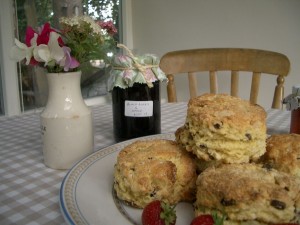Scones were originally a Scottish basic, a type of quick flat bread made with oats and without yeast. Gradually, they evolved into the sweet teatime treat we’re more familiar with today, and Mrs. Beeton, author of Britain’s first cookbook for domestic cooks, lists several recipes in her Book of Household Hints in 1861. There’s something supremely comforting about a plate of scones, and they’ve become an integral part of that very British institution the afternoon tea, which has become a tourist must-have in hotels and tearooms nationwide.
Some things, like scones and sponge cake, just have to be homemade. If you’ve never tried to make your own scones, you’ll be surprised not only at how easy it is, but also at the difference in flavour. One of the nicest things about making your own is that you can eat them warm from the oven, with the butter just starting to melt and slide off.
This is my old family recipe for scones, passed down from my great-grandmother, who used to serve them in the 1920s at her tearooms in Marple, now in Greater Manchester. It includes both butter and an egg, which not all recipes do, but you’ll notice the difference in the flavour.
Recipe for Mrs. Haslam’s scones
Obviously with this recipe being as old as it is, my original copy is in imperial measurements. I’ve added some metric measurements, but this recipe is very forgiving, and it won’t mind if you get the quantities a little wrong.
Makes 8 – 10
Ingredients
- 2oz. (60g) butter or margarine, softened
- 8oz. (225g) self raising flour, sifted (the sifting isn’t essential if you’re in a hurry, but it does make the scones lighter)
- a little extra flour for dusting
- 2oz. (60g) granulated sugar
- 1 large free range egg
- Milk
- 2oz. (60g) sultanas
Step 1. Pre-heat the oven to 180 degrees centigrade.
Step 2. Assemble the ingredients.
Step 3 – Tip the butter and flour into a large mixing bowl, and rub it in with your fingertips until the mixture looks like fine breadcrumbs.
Step 4 – Stir in the sugar and the sultanas. Now break the egg into a measuring jug, and top it up with milk until you end up with a total of 1/4 pint (140ml) of liquid. Beating the egg and milk together with a whisk will help the scones rise, but again, if you haven’t got time to do this don’t worry.
Step 5 – Pour most of the liquid into the dry ingredients, and using first a wooden spoon and then your hands, mix it thoroughly together until you end up with a ball of stiff dough. If the mixture’s too dry, add the rest of the liquid. If you add too much liquid and it goes a bit sticky, add a bit of extra flour.
Step 6 – Dust the countertop with a little flour and turn the dough onto it. Using either a rolling pin or the flat of your hand, flatten the dough to around one and a half inches thick. Cut out rounds with a pastry cutter.
Step 7 – Brush the top of the scones with milk, and bake for around 15 minutes. After that time’s elapsed, check them – you’re aiming for golden on top, but still very slightly damp yet not doughy in the middle (this is easier than it sounds). If they’re not quite done, give them another few minutes, then remove and place on a cooling rack.
Step 8 – Serve! Best with homemade jam, but also great with cream or fresh strawberries.
by Sara Walker









